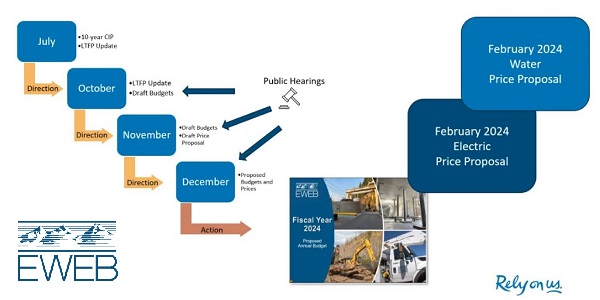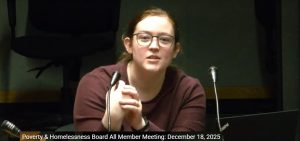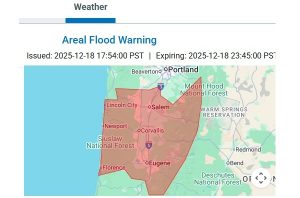EWEB to decide on 2024 rate increases Dec. 5
4 min read
EWEB’s board of directors will decide on rate increases on Dec. 5. As they moved closer to the final numbers, KEPW News was there. On Nov. 7:
DJ Suss D (KEPW News): Energy costs are going up and utilities are looking to raise rates. The median household income has gone up while Eugene Water and Electric Board rates have stayed the same. Eugene-area energy and water consumers will likely see an average $11 increase on their electric bill and $3 on their water bill. The higher rates go to maintaining and improving infrastructure. The public utility uses a cost-of-service analysis (COSA) to determine rates.
[00:00:38] What EWEB General Manager Frank Lawson says about the $3 water increase applies to how the board sets costs over time for all improvements.
[00:00:46] EWEB General Manager Frank Lawson: You know, the real simple answer is that we’re making investments in the infrastructure, and this board and staff have decided to smooth that over a number of years.
[00:00:57] Those customers do not pay for that until it goes in into service, of which if we do a, you know, a gradual, there, they will have to pay the piper at some point. And it’s not going to be a gradual, it’s going to be a step function. For example, the water tanks. And in our COSA (Cost of Service Analysis), we’re raising the rates, you know, we’ll say four percent, four percent, four percent.
[00:01:21] When those go into service and that capital hits the contracts, they might be at zero now. They’re going to have to, they’re going to jump to 12 or 15 at that time. So the big difference with some of those contracts is that we are paying for capital up front while we’re doing it, and they don’t pay it until it goes into service. And so they will have to pay the piper…
[00:01:49] There is another way of saying that is that when we’re paying for something up front, there’s a cost to that financing. And the cost of that financing eventually gets passed on through, this rate of return, that’s another way of saying it.
[00:02:05] DJ Suss D: EWEB will know more about how much long-term hydroelectric access it will have when the Bonneville Power Authority signs a 20-year contract in late 2025, as expected.
[00:02:16] EWEB’s Integrated Resource Plan relies almost solely on grid technology rather than self-generation; technologies other than hydroelectric that are the best fit for customers to achieve resource acquisition are wind, storage batteries, and modular nuclear reactors.
[00:02:33] But the grid can be a challenge to plug into. There are known unknowns and unknown unknown costs for ratepayers coming down the line.
[00:02:42] EWEB General Manager Frank Lawson: The interesting thing, and I think it came out last meeting, was the 2024 rate increase is not because the 2024 budget is any different than the 2023 budget. The reason for that is that we are positioning ourselves to make some of these significant infrastructure investments in the years, in the near years to come.
[00:03:09] And so, to be able to fund those, to be in good financial position to borrow money at good rates, you have to set yourself up financially to do that. It is not because our 2024 budget is 7% higher than our 2023.
I believe, but this has to be discussed, that we need to better align our fixed costs with our variable costs. That’s in order to set the baseline, to be able to offer some of the future products and services.
[00:03:41] The second phase will be to create the mechanisms to be able to reward people who can save us on the capacity pieces. So the peak pieces, for example, to be able to set this up for time-of-use rates and things like that.
[00:03:57] And then the third one is the very specific products and services around demand response and other things that we want. And I suspect, I expect that to take probably two or three years to implement. But that will be, when we come back next month and talk about the 2024 goals, rate design will be one of the goals that we want to launch into, including a better alignment between fixed and variable costs.
[00:04:25] DJ Suss D: EWEB’s IRP (Integrated Resource Plan) claims that despite its predictability and prevalence of available surface area, rooftop solar and cogeneration are not worth the cost of the self-sufficiency and energy independence ratepayers would gain. The way the state’s net metering is structured, all EWEB customers are paying rooftop solar owners for the surplus energy rooftop panels generate.
[00:04:45] Even with current self-generation from rooftop solar, most customers will draw from the grid during winter peak usage, so solar generation in the winter would have to be supplemented in some way to meet demand of any scale. Even though summer usage is still lower than hotter states, revenue potential homeowners and businesses received from selling to the grid is predicted to go down.
[00:05:02] While overall usage is expected to rise as electric vehicles become more obtainable, encouraging conservation with rebates for more efficient appliances is the way they’ll keep prices down.
[00:05:14] EWEB is a customer-owned public utility. They provide electricity to about 100,000 customers and water service to more than 60,000 customers in the Eugene area. They purchase most of their electricity from the Bonneville Power Authority.
[00:05:26] For KEPW News, I’m DJ Suss D.
February 2024 Electric Price Proposal, page 8: The resulting monthly average electric bill based on this proposal is $190.12, an increase of $11.10 over 2023.
February 2024 Water Price Proposal, page 7: The resulting monthly average water bill based on this proposal is $43.30, an increase of $3.09 over 2023.
Integrated Resource Plan, page 6: Zero-carbon, dispatchable resources will likely be necessary in the future. As EWEB and the Pacific Northwest region pursue full decarbonization, there will likely be a need for dispatchable resources like small modular nuclear reactors (SMR) or geothermal that do not create emissions and can be relied upon for extended periods of time.






